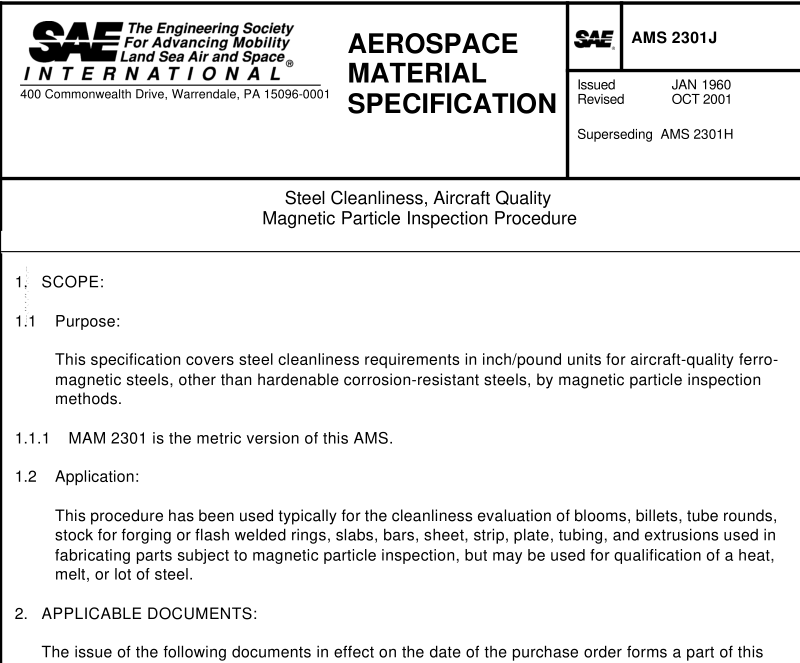SAE AMS 2301:2001 pdf download Steel Cleanliness, Aircraft Quality Magnetic Particle Inspection Procedure
1 . SCOPE:
1 .1 Purpose: This specification covers steel cleanliness requirements in inch/pound units for aircraft-quality ferro- magnetic steels, other than hardenable corrosion-resistant steels, by magnetic particle inspection methods.
1 .1 .1 MAM 2301 is the metric version of this AMS.
1 .2 Application: This procedure has been used typically for the cleanliness evaluation of blooms, billets, tube rounds, stock for forging or flash welded rings, slabs, bars, sheet, strip, plate, tubing, and extrusions used in fabricating parts subject to magnetic particle inspection, but may be used for qualification of a heat, melt, or lot of steel.
2. APPLICABLE DOCUMENTS: The issue of the following documents in effect on the date of the purchase order forms a part of this specification to the extent specified herein. The supplier may work to a subsequent revision of a document unless a specific document issue is specified. When the referenced document has been canceled and no superseding document has been specified, the last published issue of that document shall apply.
2.1 ASTM Publications:
Available from ASTM, 1 00 Barr Harbor Drive, West Conshohocken, PA 1 9428-2959.
ASTM E 1 0 Brinell Hardness of Metallic Materials
ASTM E 1 444 Magnetic Particle Examination
2.2 ANSI Publications:
Available from American National Standards Institute, Inc., 25 West 43rd Street, New York, NY 1 0036-8002.
ANSI B46.1 Surface Texture
3. TECHNICAL REQUIREMENTS:
3.1 Specimen Preparation:
3.1 .1 Heat Qualification: Sampling shall be in accordance with 4.3.1 . Samples shall be converted into test specimens in accordance with 3.1 .3.
3.1 .2 Product Qualification: Product from a heat not qualified based on sampling as in 4.3.1 shall be sampled in accordance with 4.3.2. Samples shall be converted into test specimens in accordance with 3.1 .3.
3.1 .3 Working and Rough Machining:
3.1 .3.1 Solid Product 1 2 Inches and Over in Nominal Diameter or Distance Between Parallel Sides: A quarter-section shall be cut from each sample sufficiently oversized that the center of the original sample will be approximately on the surface of the specimen after generating to test size. The quarter-section shall then be forged to a 3 to 6 inch round or square, maintaining the axis of the forging approximately parallel to the original direction of rolling. As an alternate method, the full section may be rolled or forged to a 6-inch round or square and an oversize quarter obtained as in 3.1 .3.3. Specimens shall be rough machined to a “one-step” straight cylinder nominally 5 inches long. Minimum stock removal shall be consistent with the machining allowance specified in 3.1 .4.
3.1 .3.2 Solid Product Over 6 to 1 2 Inches, Exclusive, in Nominal Diameter or Distance Between Parallel Sides Except Slabs and Plates: A quarter-section shall be cut from each sample sufficiently oversize that the center of the original sample will be approximately on the surface of the specimen after generating to test size. The quarter-section shall be converted into a test specimen by machining, or forging and machining, to a 3 to 6 inch round or square. Specimens shall be rough machined to a “one-step” straight cylinder nominally 5 inches long. Minimum stock removal shall be consistent with the machining allowance specified in 3.1 .4.
3.1 .3.3 Solid Product 6 Inches and Under in Nominal Diameter or Distance Between Parallel Sides Except Flat Bars, Slabs, and Plates: A quarter-section shall be cut from each sample sufficiently oversize that the center of the original sample will be approximately on the surface of the specimen after generating to test size. The quarter-section shall be converted into a test specimen by machining to a “one-step” straight cylinder nominally 5 inches long. Minimum stock removal shall be consistent with the machining allowance specified in 3.1 .4.
SAE AMS 2301:2001 pdf download
